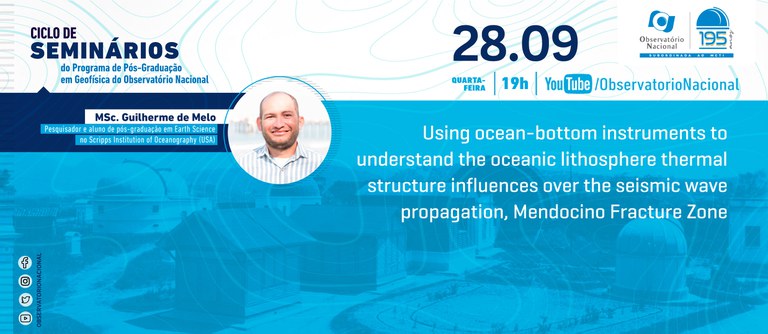Notícias
Seminário da Geofísica do ON: transmissão ao vivo dia 28/09 às 19h

Na próxima quarta-feira, dia 28 de setembro, o Programa de Pós-Graduação em Geofísica do Observatório Nacional (PPGG/ON) realizará uma nova edição de seu Ciclo de Seminário de interesse da comunidade geofísica.
O tema do evento, que acontecerá às 19h (horário de Brasília) de forma online por meio do canal do ON no YouTube, será “Using ocean-bottom instruments to understand the oceanic lithosphere thermal structure influences over the seismic wave propagation, Mendocino Fracture Zone” (ou “Usando instrumentos de fundo oceânico para entender as influências da estrutura térmica da litosfera oceânica sobre a propagação das ondas sísmicas, Zona de Fratura de Mendocino”, em português)
Para falar sobre o assunto, foi convidado o pesquisador Guilherme Weber Sampaio de Melo. Ele possui licenciatura em Física, bacharelado em Geofísica e mestrado em Geodinâmica e Geofísica pela Universidade Federal do Rio Grande do Norte (UFRN). Fez parte de sua pesquisa de mestrado no Institut Universitaire Européen de la Mer, na França, além de outros dois trabalho como pesquisador visitante no Scripps Institution of Oceanography (University of California San Diego) em Dezembro de 2019, e outra no Lamont-Doherty Earth Observatory (Columbia University) em Janeiro de 2020. Guilherme já recebeu prêmios como Menção Honrosa de melhor trabalho em Geociências da UFRN em 2015, uma prestigiosa Grants do Scientific Committee on Ocean Research (SCOR), em agosto de 2019, um Fellowship da InterRidge Corporation também em 2019, um Travel Grants da Seismological Society of American em 2021, e recentemente um outro Travel Grants da Columbia University para participar do Marine Geoscience Data Resources training que ocorrerá no Lamont-Doherty no final do mês que vem (Oct. 2022). Hoje ele é pesquisador e aluno no segundo ano de pós-graduação em Earth Science no Scripps Institution of Oceanography, em San Diego, CA, USA.
Título da palestra: Using ocean-bottom instruments to understand the oceanic lithosphere thermal structure influences over the seismic wave propagation, Mendocino Fracture Zone
Abstract: Cooling of the oceanic lithosphere with age causes an increase in thickness and seismic velocity. Seismic compressional waves propagating in oceanic uppermost mantle (Pn waves) generally travel at velocities in 8.0-8.2 km/s range. However, there are some variations in Pn velocity in different ocean basins perhaps due to different spreading rates. Using hydrophone records, previous authors have shown estimations of Pn velocities ranging 7.5-8.0 km/s in Pacific, and an average from 7.8 to 8.5 km/s in the cold upper mantle of the equatorial Atlantic ocean. Therefore, the study of variations in seismic wave velocities is crucially important to understanding the effect of spreading rate and lithospheric age, on the velocity structure of the lithosphere in different ocean basins. Here, we analyze Pn wave velocities, teleseismic P waves delays, and thermal structure modeling of the oceanic lithosphere beneath Mendocino Fracture Zone (MFZ), Pacific ocean. We used records of 16 regional earthquakes identified with a set of 20 sea-bottom instruments deployed in a 200 km long N-S array across the Mendocino Fracture zone having an age offset of 26 Ma. We also analyzed the variations of P wave arrival times from 20 teleseismic earthquakes (Mw>7) recorded by sea-bottom instruments of USArray using cross-correlation. Preliminary results obtained show an uppermost mantle seismic velocity variation with ±0.3 km/s comparing the Using ocean-bottom instruments to understand the oceanic lithosphere thermal structure influences over the seismic wave propagation, Mendocino Fracture Zone lithosphere in basins of the two sides of MFZ. We observe a partial according of the Pn velocities with age variations and uppermost mantle temperatures modeled crossing the MFZ. The north/young crust showing average Pn velocity ∼8.08 km/s with the higher velocities with average of ∼8.41 km/s in south/older lithosphere. These velocities are lower when compared to previous articles in the equatorial Atlantic. First results of the waveform cross-correlation shows us differences in teleseismic P waves travel times since 0.17 to 0.5 s for the two sides of MFZ. Therefore, these results in MFZ can indicate that younger/older sides of the fracture zones can present the existence of a complex geodynamical mechanism beneath the lithosphere, in which the behavior of the seismic wave propagation can vary depending on the settings in uppermost mantle of each ocean basin.
Clique aqui para assistir a live
Não perca! Na próxima quarta-feira, dia 28 de setembro, às 19h.